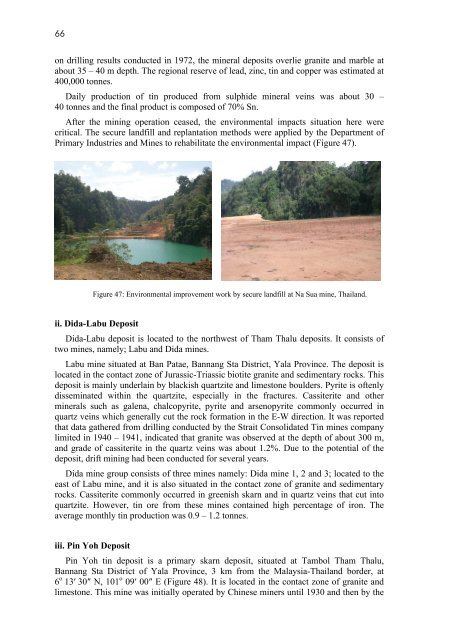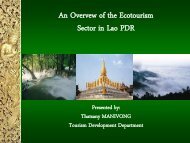GEOLOGY OF THE PENGKALAN HULU-BETONG TRANSECT ...
GEOLOGY OF THE PENGKALAN HULU-BETONG TRANSECT ...
GEOLOGY OF THE PENGKALAN HULU-BETONG TRANSECT ...
Create successful ePaper yourself
Turn your PDF publications into a flip-book with our unique Google optimized e-Paper software.
66<br />
on drilling results conducted in 1972, the mineral deposits overlie granite and marble at<br />
about 35 – 40 m depth. The regional reserve of lead, zinc, tin and copper was estimated at<br />
400,000 tonnes.<br />
Daily production of tin produced from sulphide mineral veins was about 30 –<br />
40 tonnes and the final product is composed of 70% Sn.<br />
After the mining operation ceased, the environmental impacts situation here were<br />
critical. The secure landfill and replantation methods were applied by the Department of<br />
Primary Industries and Mines to rehabilitate the environmental impact (Figure 47).<br />
Figure 47: Environmental improvement work by secure landfill at Na Sua mine, Thailand.<br />
ii. Dida-Labu Deposit<br />
Dida-Labu deposit is located to the northwest of Tham Thalu deposits. It consists of<br />
two mines, namely; Labu and Dida mines.<br />
Labu mine situated at Ban Patae, Bannang Sta District, Yala Province. The deposit is<br />
located in the contact zone of Jurassic-Triassic biotite granite and sedimentary rocks. This<br />
deposit is mainly underlain by blackish quartzite and limestone boulders. Pyrite is oftenly<br />
disseminated within the quartzite, especially in the fractures. Cassiterite and other<br />
minerals such as galena, chalcopyrite, pyrite and arsenopyrite commonly occurred in<br />
quartz veins which generally cut the rock formation in the E-W direction. It was reported<br />
that data gathered from drilling conducted by the Strait Consolidated Tin mines company<br />
limited in 1940 – 1941, indicated that granite was observed at the depth of about 300 m,<br />
and grade of cassiterite in the quartz veins was about 1.2%. Due to the potential of the<br />
deposit, drift mining had been conducted for several years.<br />
Dida mine group consists of three mines namely: Dida mine 1, 2 and 3; located to the<br />
east of Labu mine, and it is also situated in the contact zone of granite and sedimentary<br />
rocks. Cassiterite commonly occurred in greenish skarn and in quartz veins that cut into<br />
quartzite. However, tin ore from these mines contained high percentage of iron. The<br />
average monthly tin production was 0.9 – 1.2 tonnes.<br />
iii. Pin Yoh Deposit<br />
Pin Yoh tin deposit is a primary skarn deposit, situated at Tambol Tham Thalu,<br />
Bannang Sta District of Yala Province, 3 km from the Malaysia-Thailand border, at<br />
6 o 13′ 30″ N, 101 o 09′ 00″ E (Figure 48). It is located in the contact zone of granite and<br />
limestone. This mine was initially operated by Chinese miners until 1930 and then by the



